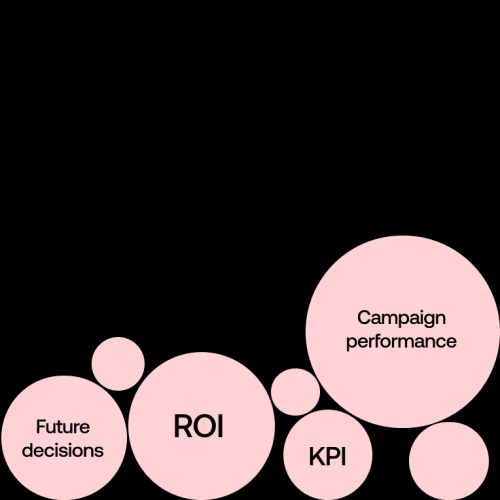Brand marketing is an important aspect of any business . It helps to establish the brand’s identity, build customer loyalty, and differentiate the brand from its competitors.
Strong branding can also increase the value of the company and make it more attractive to potential investors or buyers. Effective brand marketing helps to communicate the value and benefits of the brand to its target audience. This can ultimately lead to increased sales and revenue.
It is important to continually invest in brand marketing efforts to maintain and strengthen the brand’s reputation and presence in the market.
? Read Creating a Marketing Strategy that Works: Benefits, Steps, Tools
Below are 6 specific steps you can take to build a brand marketing strategy. We’ll also discuss how to use tools like Determ to assist in brand marketing activities like market research, competitor analysis and brand monitoring.
Step 1: Define the Demographics of Your Target Audience
Defining a target audience is the first step in building a brand marketing strategy. A target audience is the group of consumers that a brand is trying to reach with its marketing efforts.
There are several ways to define a target audience, including considering demographic characteristics such as:
- age
- gender
- income
- education level
- geographic location
There are also psychographic characteristics such as values, interests, and lifestyles.
Marketers can use market research techniques like surveys, focus groups, and customer interviews to gather more detailed and specific information about the target audience.
It is important to have a clear understanding of the target audience to create marketing campaigns and messaging that will effectively resonate with them.
Step 2: Determine Your Brand Positioning
Determining your brand positioning is the next important step in building a brand marketing strategy. It involves defining what makes your brand unique. It also involved thinking about how you want your brand to be perceived by your target audience.
To determine your brand positioning, you should consider what sets your brand apart from your competitors. Consider the value it offers to your customers.
You should also think about the emotional and functional benefits of your brand and how it fits into the needs and desires of your target audience.

Competitor analysis can also be useful in this process, as it allows you to understand how your brand compares to others in the market. It also reveals what opportunities or gaps exist for your brand to differentiate itself.
Ultimately, your brand positioning should be reflected in all aspects of your marketing efforts, from messaging to visuals to customer experience. Here is an example of a brand positioning strategy:
- Brand: Nike
- Target audience: Athletes and active individuals
- Brand positioning: Nike is the leading brand for athletes and active individuals, offering high-quality, innovative, and stylish athletic apparel, footwear, and accessories. We are committed to helping athletes and active individuals reach their full potential and achieve their goals through the power of sport. Our brand is all about pushing boundaries, breaking records, and inspiring people to be their best selves.
- Key messages: “Just Do It”, “Believe in Something”, “Be Your Best”
- Key slogans: “The Future Is Yours”, “The Power of Sport”, “Make It Count”
- Marketing channels: Social media, digital advertising, influencer partnerships, in-store marketing, events, and sponsorships.

Step 3: Set SMART Brand Marketing Goals
Setting your brand marketing goals helps to define what you want to achieve and provides a way to measure the success of your efforts.
To create effective goals, it is important to use the SMART criteria. SMART stands for Specific, Measurable, Achievable, Relevant, and Time-bound. This means that your goals should be specific and clearly defined, able to be measured, and realistically achievable with the resources available. They should be relevant to your business and target audience and have a specific timeline for completion.
For example, a SMART goal for increasing brand awareness could look something like this:
- Specific: Increase brand awareness among our target audience of young professionals in the U.S. by 20% within the next six months.
- Measurable: We will measure brand awareness using a combination of online surveys and social media analytics, including metrics such as website traffic, engagement rates, and hashtag usage.
- Achievable: We have the resources and budget to allocate towards marketing efforts such as social media advertising, email marketing, and influencer partnerships. We believe it will be effective in reaching our target audience.
- Relevant: Increasing brand awareness among young professionals is relevant to our business goals. This group represents a key demographic for our products and services
- Time-bound: This goal will be completed within the next six months. After that we will reevaluate and set new brand awareness goals as needed.
Step 4: Develop Your Story and Tone of Voice
Developing a brand messaging strategy involves crafting the words and language that will be used to communicate your brand to your target audience. There are 3 key elements to consider when developing a brand messaging strategy:
- Crafting a brand voice and tone – The voice and tone of your brand should be consistent across all marketing materials. It should reflect the personality and values of your brand.
- Creating a brand story – A brand story helps to establish the unique identity and character of your brand. It should be authentic, compelling, and relevant to your target audience.
- Developing key messages and slogans – Key messages are specific points that you want to communicate about your brand. Slogans are brief, memorable phrases that capture the essence of your brand. Both should be aligned with your overall brand messaging strategy and be used consistently across all marketing channels.
By developing a strong brand messaging strategy, you can effectively communicate the value and benefits of your brand. This helps you to your target audience better and build a strong emotional connection with them.

The tone of voice that you have developed for your brand should be consistent across all marketing and sales materials. This includes:
- Brochures: Print or digital brochures that provide detailed information about a product or service.
- Business cards: Small cards that contain contact information for a professional introduction.
- Presentation decks: Slideshow presentations and pitch decks for presenting or pitching your product or service
- Sales scripts: Detailed scripts that salespeople use to guide their interactions with potential customers.
- Product samples: Physical samples of a product that can be used to demonstrate its features and benefits.
- Landing pages: Web pages that are specifically designed to convert visitors into paying customers.
- Email marketing: Marketing emails that are sent to a list of subscribers in order to promote products or services.
- Social media marketing: Marketing efforts on social media platforms, such as Facebook, Instagram, and Twitter.
Step 5: Choose Primary Marketing Channels According to Audience Demographics
When choosing the right marketing channels for conveying your brand marketing effectively, think about what type of media your target audience consumes. There is a wide range of channels available, for example:
- traditional channels such as print, TV, and radio
- digital channels such as social media, email marketing, and your website
- include influencer marketing
- trade shows and events
The best channels for your brand will depend on your target audience, budget, and marketing goals. Some factors to consider when choosing marketing channels include:
- Reach: How many people will be exposed to your marketing efforts through this channel?
- Target audience: Does this channel allow you to effectively reach and communicate with your target audience?
- Cost: What is the cost of using this channel, and does it fit within your budget?
- Effectiveness: Is this channel known to be effective for achieving the goals you have set for your brand marketing efforts?
It is often helpful to use a combination of channels. This ultimately helps you to reach a wider audience and communicate your brand marketing messages more effectively.
It is also important to continually analyze the effectiveness of your marketing channels and adjust your strategy as needed.
One of the best tools for developing a brand marketing strategy is Determ. It allows for brand monitoring, market research, competitor analysis and several other features.
Step 6: Implement and Track Brand Marketing Efforts
Implementing and tracking brand marketing efforts is an ongoing process that is essential to the success of your brand marketing strategy. There are several key steps involved in this process:
Create a Content Calendar
To help ensure that you are consistently sharing relevant and valuable content with your audience, it is helpful to create a content calendar. This can be done using the best social media management tools, which allow you to discover, schedule, and publish content on multiple channels in advance.
Track Key Brand Metrics
To gauge the effectiveness of your brand marketing efforts, it is important to track key metrics. These key metrics could be website traffic, social media engagement, and sales figures. Choose the KPIs that match with your ultimate business goals.

For measuring offline brand marketing efforts, you can use a QR code generator. By adding a QR code with a CTA (Call to action) to your marketing collateral you can capture the efficiency of offline ads.
This allows you to measure how well your offline campaign turned out to be. Also, you will get to know your target audience a bit better.
Analyze the Data Using the Right Tools
Once you have collected data on your brand metrics, it is important to analyze the results. The goal after all is to understand what is working well and what areas need improvement.
If you’re a B2B business, you might have a few core metrics unique to your brand. These can be metrics like churn rate, annual recurring revenue, customer acquisition costs, lifetime value, etc.
If you’re a B2C company, this might include metrics like daily active users, lead score, marketing ROI, among others.
Using simple marketing analytics tools might cut it for a while, but as you’re growing, and the number of tools you’re using is also growing. As that happens, you need to upgrade your processes + data stack. If you’re already using a data warehouse for data aggregation, then most likely you’re using ELT systems for data transfer.
However, in order to fully utilize that enriched customer data and transaction data, you should sync data from your warehouse to any tool. Use reverse ETL to feed your newly collected data from your database or data warehouse back into your CRM, marketing and sales tools. This feeds the data to platforms where you can take action on it.

Adjust Marketing Efforts Based on Data and Feedback
Based on your analysis of the data, you may need to make adjustments to your brand marketing efforts. This may include changing the types of content you share, altering your messaging, or using different marketing channels.
It is also important to listen to feedback from your target audience. Based on that feedback, you might need to adjust your strategy to better meet their needs and preferences.
Track and analyze your brand marketing efforts continuously. By doing that you can ensure that you are making progress toward your goals and making the most of your marketing resources.
Key Takeaways for Creating a Brand Marketing Strategy
Brand marketing is a crucial aspect of any business. It helps to establish the brand’s identity, build customer loyalty, and differentiate the brand from its competitors.
It is important to continually invest in brand marketing efforts to maintain and strengthen the brand’s reputation and presence in the market.
There are 6 steps to building a brand marketing strategy. The first step is defining the target audience. Secondly, determining the brand positioning. Third, setting SMART brand marketing goals. Next, developing a brand messaging strategy. Then choosing marketing channels. Finally, implementing and tracking brand marketing efforts.
To define the target audience, marketers should consider demographic and psychographic characteristics and use market research techniques.
Read Market Research Process in 4 Steps
Determining the brand positioning involves defining what makes the brand unique. It involved exploring how it should be perceived by the target audience. And also, how it compares against the competitors.
A brand messaging strategy includes creating a brand story. The brand story includes crafting a brand voice and tone. The key messages and slogans are also a central piece in that.
Marketing channels to consider include traditional channels, digital channels, influencer marketing, and events.
To implement and track brand marketing efforts, marketers should track brand metrics, analyze results. The point of tracking is to learn and adjust the marketing efforts based on data and feedback.
Erkki is the founder of influno.com, which helps entrepreneurs, marketers and sales managers make the best decisions on the business tools to drive their businesses forward. Erkki’s background is in IT and software product management.






